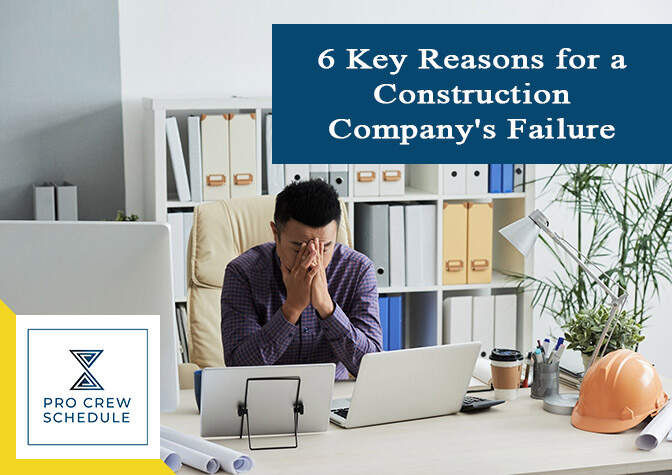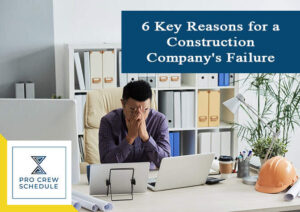Even the most successful construction company went through the risk of failing. It’s a normal part of any business. The Small Business Administration previously revealed the surprisingly high failure rate among startup companies. The report revealed that around 20 percent of companies in the U.S. failed in their first year of operation while 50 percent flopped within their first five years.The construction industry is in an even more unfortunate position. Over 60 percent of the U.S. construction companies were said to have closed down within their first five years of operation. These companies reportedly blamed several factors for their failure, including labor shortage, politics, insurance, taxes, natural disasters, and subcontractor incompetence.
But looking into the root cause of the problems, one will realize that the real factors that brought about a construction company’s failure are internal and within the owner’s control. The real reasons? They are more likely because of poor planning, inaccurate builder schedule, hiring the wrong people, inability to innovate, and unskillful project managers, among many others.
The good news is that the new generation of construction businesses can learn from their forefathers’ mistakes and avoid falling for the same reasons. And that is what we’re going to look into this article.
Failing U.S. Construction Companies
Running a business isn’t easy. We’ve been discussing in some previous articles about several risks faced by the industry. Unfortunately, some of them are uncontrollable, like natural disasters and economic challenges. But throughout the years, project managers have learned better techniques in managing construction, and we’ve jotted them down too in previous articles. Thanks to innovations like construction scheduling software, BIM, reality techs, automation, and so on, construction firms become more resistant to closure.
Problems placing construction companies at risk of shutting down may not always be easy to fix. It takes a lot of planning, consistent construction crew management, hard work, and discipline to keep things in order and keep the business running smoothly. But at least, most issues are controllable. Plus, finding out what lies ahead and what challenges should be faced may help companies prepare for the worst.
So, here’s a long list of possible reasons for construction companies to go out of business. We also added some practical tips on how to deal with them.
1. Business Capital and Cash Flow
One of the many reasons why startup construction companies fail is the unwise use of funds. Some companies don’t even have enough money to begin with.
The ultimate dream of any professional in the construction industry is to start their firm and earn bigger by doing business than saving from their monthly paycheck. But it’s never as simple as gathering your team and winning a bid. The most critical factor in starting a business is to have capital that can sustain the operations in the company’s first year.
The funds should indeed come from the client, but as we all know too, some clients also find it hard to pay their bills on time. For these reasons, some construction companies use their own money first to keep the project going.
Additionally, construction activities require the use of tools, vehicles, and heavy equipment. For construction companies to win a bid, they should have all these fixed assets, and they aren’t cheap.
Finally, construction companies should financially prepared to face surprises. Unexpected situations like subcontractor errors, accidents, resignations, equipment breakdowns, weather disturbances, and other natural disasters can deplete your capital. Hence, your firm should have a buffer to get you through all these big surprises.
How to deal with insufficient capital?
There are banks and lending companies in the U.S. that support startup construction companies. Businesses can take loans to support their needs. Apart from that, proper cash flow management should be observed. To do that, companies hire experienced accountants to manage finances properly. Make sure that you are paid on time too. Include the timing of billing in your contract so that you will have a steady flow of funds to sustain your operation.
Finally, maintain positive cash flow. Have a budget to pay your debts and expenses and for your emergencies. Overlooking these things can quickly lead your company to failure.
2. Poor Project Performance
One lousy project delivered can lead to a construction company’s closure. Construction projects are all about good results. If you fail to deliver on time and within the requirements, your business is good as done.
One building may cost millions of dollars, and project owners won’t let you get away if you can’t deliver that worth. You are lucky if they won’t file legal complaints about not following the contract.
You have to be sure then that you deliver profitable projects. To do that, you have to:
- Hire proficient project managers
- Hire the right people
- Innovate with modern tools and equipment
- Streamline your processes with project management software
- Estimate job costing accurately
- Plan and schedule construction activities smartly
- Minimize errors with BIM
- Prepare for unexpected issues
- Check on project status daily
- Wiser decision making
- Teamwork
It is also helpful to choose projects that you can confidently handle. It’s good to take new challenges and level up your business, but accepting job orders that your team, budget, and equipment cannot control may just lead to your company’s failure.
3. Failure to Plan Properly
We always mention how strategic planning can lead to a successful project. That’s because a good project starts with a good pre-construction phase.
In your project planning, you have to define your goals and set the activities according to them and the owner’s requirements. A good builder schedule then follows. With the help of a reliable construction scheduling software like Pro Crew Schedule, all these are possible.
Define roles, too, and hire accordingly. We know that there’s an ongoing labor shortage in the industry, but you shouldn’t lower your standards so that you can fill in roles. By looking at the right places, you can surely gather the right team members. You can check our blog about the best websites to search for the best construction workers and subcontractors.
Constant communication also helps. Be in touch with all stakeholders during the planning stage so you can take their ideas and opinion on the best approaches for each project phase. A project management software you can share with your crew and subcontractors will help you with this goal.
4. Aiming to Grow Business Very Aggressively
Did you know that wanting to grow your business may also lead to your construction company’s failure? It may sound crazy, but it’s true, most especially for startups.
Even successful and years-old construction companies can find it challenging to manage multiple projects, what more for a young and inexperienced firm? Trying to be aggressive early on your operation without the right amount of resources like funds and workforce and sufficient knowledge can make your growth slower than faster. It is nice to have an ambition and goal, but construction isn’t a business where you can gamble big without testing your cards first.
Do not take too much work that your team cannot handle. Some small companies agree to tight schedules and still accept other projects that often lead them to cram and deliver poor project results.
Be strategic when planning your business expansion and take on larger projects incrementally. Never think that you can turn your $10,000 company into a $10,000,000 company overnight. Start with one project where you can gain experience and win referrals. Then you can hire more staff so you can take on two projects on your next round and so on until you can perfect your process and organization to take on multiple projects at the same time.
Making your people stick with you can also help you in your expansion goals. As you know, it isn’t easy to start back to zero every time you start a project. Hiring now and then and training them anew is a lot of work. Check out our tips on motivating your crew members as you can use those strategies to make them stay with your company too.
5. Inability to Innovate
Construction is heavy manual labor- that was centuries and decades ago. In this modern world, scientists produce tools that can make the work faster, lighter, and more profitable. If you cannot adapt to these changes, you will be easily defeated and overtaken by companies that embrace new construction technologies.
The ConTech Report authored by JBKnowledge, Inc. revealed that roughly 43.2% of construction companies use dedicated to research and have a development budget for improving their technology. Only 46% of construction firms spend a portion of their annual sales on IT, which only amounts to 1%. This fact can be detrimental to businesses trying to move a step forward as construction is much dependent on data, which, in this generation, is processed through IT.
To survive the modern world’s challenges, construction companies need to use at least the most basic construction technologies and digital tools. These include the use of BIM, construction scheduling software, automated equipment, and power tools. Later on, when you expand, you can start using drones, robots, big data, and mixed reality to enhance your company’s overall performance.
6. Neglecting Construction Project Management Improvement
Managing construction is an essential ingredient in a company’s success. Not doing anything to enhance your project management can lead your business down the drain. And it starts from project planning up to project submission.
Like we mentioned earlier, the planning stage is the start of a project’s success, so it should be done carefully. This phase includes setting goals, planning activities, scheduling and setting timelines, coordinating with all stakeholders, budgeting, and approving plans. Since the output in this sage will define your operation’s smoothness, everything should be well-documented and organized for reference during the construction.
Then next is the main construction activities. This stage is long and involves a lot of responsibilities on the part of the project managers. Checking the status of the project and team performance, monitoring the expenses, problem-solving, and keeping the project on track are the project managers’ main responsibilities. But all these can be less complicated with proficient construction crew management skills and the use of project management software.
Furthermore, communication and collaboration are two essential requirements for effective construction management. Sticking with traditional methods like pen and paper documentation and emails or phone calls can keep communication and collaboration slow. So going digital is your only option if you want to make these processes faster.
Final Words
Many risks are lurking in the construction grounds that can make a company go crumbling down. Looking into this list, the best way to stop your company from falling into the pit is to be more strategic while avoiding to be unnecessarily aggressive and to embrace changes.
The road to success in the construction industry may be long and rough, but a startup can become as well-established as the country’s biggest construction firms. Be more competitive through technology, improve your management skills; take it one step at a time, and soon enough, you can achieve your ultimate business goals.







